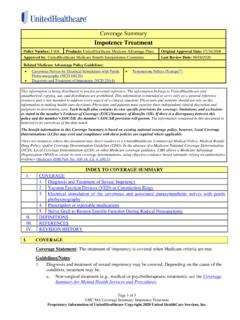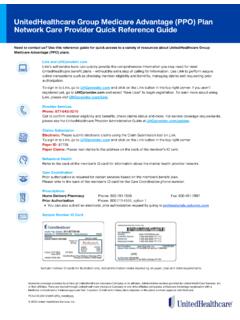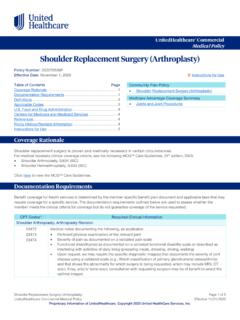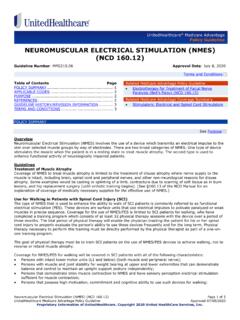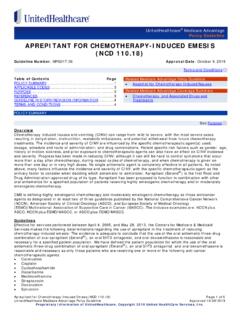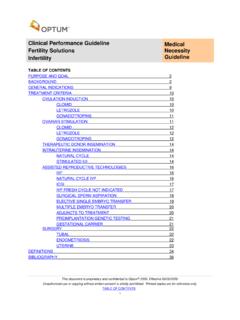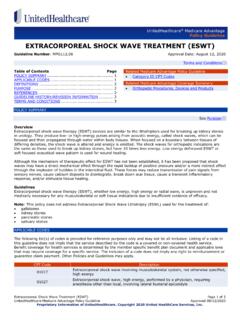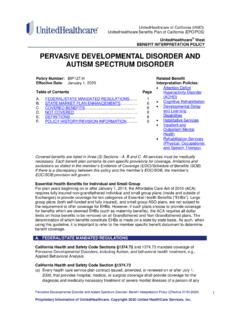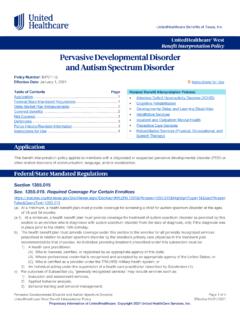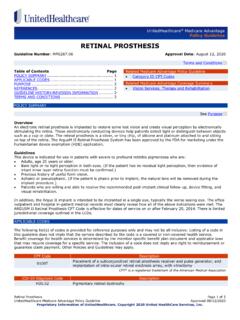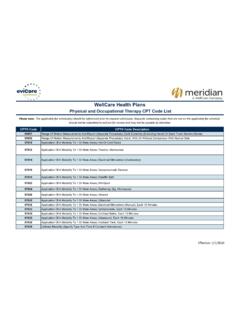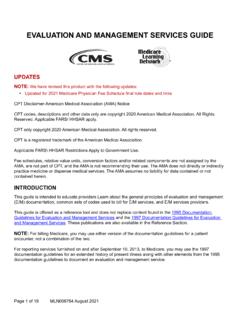Transcription of Computed Tomography (NCD 220.1) - UHCprovider.com
1 Computed Tomography (NCD ) Page 1 of 7 UnitedHealthcare Medicare Advantage Policy Guideline Approved 04/08/2020 Proprietary Information of UnitedHealthcare. Copyright 2020 United HealthCare Services, Inc. Computed Tomography (NCD ) Guideline Number: Approval Date: April 8, 2020 Table of Contents Page POLICY SUMMARY .. 1 APPLICABLE CODES .. 2 PURPOSE .. 5 REFERENCES .. 5 GUIDELINE HISTORY/REVISION INFORMATION .. 7 TERMS AND CONDITIONS .. 7 POLICY SUMMARY Overview Diagnostic examinations of the head (head scans) and of other parts of the body (body scans) performed by computerized Tomography (CT) scanners are covered if medical and scientific literature and opinion support the effective use of a scan for the condition, and the scan is: (1) reasonable and necessary for the individual patient; and (2) performed on a model of CT equipment that meets the criteria below.
2 CT scans have become the primary diagnostic tool for many conditions and symptoms. CT scanning used as the primary diagnostic tool can be cost effective because it can eliminate the need for a series of other tests, is non-invasive and thus virtually eliminates complications, and does not require hospitalization . Guidelines Determining Whether a CT Scan Is Reasonable and Necessary Sufficient information must be provided with claims to differentiate CT scans from other radiology services and to make coverage determinations. Carefully review claims to insure that a scan is reasonable and necessary for the individual patient; , the use must be found to be medically appropriate considering the patient's symptoms and preliminary diagnosis.
3 There is no general rule that requires other diagnostic tests to be tried before CT scanning is used. However, in an individual case the contractor's medical staff may determine that use of a CT scan as the initial diagnostic test was not reasonable and necessary because it was not supported by the patient's symptoms or complaints stated on the claim form; , "periodic headaches." Claims for CT scans are reviewed for evidence of abuse which might include the absence of reasonable indications for the scans, an excessive number of scans or unnecessarily expensive types of scans considering the facts in the particular cases.
4 Approved Models of CT Equipment: 1. Criteria for Approval: In the absence of evidence to the contrary, the contractor may assume that a CT scan for which payment is requested has been performed on equipment that meets the following criteria: a. The model must be known to the Food and Drug Administration (FDA), and b. Must be in the full market release phase of development. Should it be necessary to confirm that those criteria are met, ask the manufacturer to submit the information in subsection If manufacturers inquire about obtaining Medicare approval for their equipment, inform them of the foregoing criteria.
5 2. Evidence of Approval: a. The letter sent by the Bureau of Radiological Health, Food and Drug Administration (FDA), to the manufacturer acknowledging the FDA's receipt of information on the specific CT scanner system model submitted as required under Public Law 90-602, "The Radiation Control for Health and Safety Act of 1968." b. A letter signed by the chief executive officer or other officer acting in a similar capacity for the manufacturer which: Related Medicare Advantage Coverage Summaries Computed Tomographic Angiography (CTA)/ Electron Beam Computed Tomography (EBCT) of the Chest Gastroesophageal and Gastrointestinal (GI) Services and Procedures Radiologic Diagnostic Procedures UnitedHealthcare Medicare Advantage Policy Guideline See Purpose Terms and Conditions Computed Tomography (NCD ) Page 2 of 7 UnitedHealthcare Medicare Advantage Policy Guideline Approved 04/08/2020 Proprietary Information of UnitedHealthcare.
6 Copyright 2020 United HealthCare Services, Inc. i. Furnishes the CT scanner system model number, all names that hospitals and physicians' offices may use to refer to the CT scanner system on claims, and the accession number assigned by FDA to the specific model; ii. Specifies whether the scanner performs head scans only, body scans only ( , scans of parts of the body other than the head), or head and body scans; iii. States that the company or corporation is satisfied with the results of the developmental stages that preceded the full market release phase of the equipment, that the equipment is in the full market release phase, and the date on which it was decided to put the product into the full market release phase Mobile CT Equipment CT scans performed on mobile units are subject to the same Medicare coverage requirements applicable to scans performed on stationary units.
7 As well as certain health and safety requirements recommended by the Health Resources and Services Administration. As with scans performed on stationary units, the scans must be determined medically necessary for the individual patient. The scans must be performed on types of CT scanning equipment that have been approved for use as stationary units (see C above), and must be in compliance with applicable State laws and regulations for control of radiation. 1. Hospital Setting: The hospital must assume responsibility for the quality of the scan furnished to inpatients and outpatients and must ensure that a radiologist or other qualified physician is in charge of the procedure.
8 The radiologist or other physician ( , one who is with the mobile unit) who is responsible for the procedure must be approved by the hospital for similar privileges. 2. Ambulatory Setting: If mobile CT scan services are furnished at an ambulatory health care facility other than a hospital-based facility, , a freestanding physician-directed clinic, the diagnostic procedure must be performed by or under the direct personal supervision of a radiologist or other qualified physician. In addition, the facility must maintain a record of the attending physician's order for a scan performed on a mobile unit.
9 3. Billing for Mobile CT Scans: Hospitals, hospital-associated radiologists, ambulatory health care facilities, and physician owner/operators of mobile units may bill for mobile scans as they would for scans performed on stationary equipment. 4. Claims Review: Evidence of compliance with applicable State laws and regulations for control of radiation should be requested from owners of mobile CT scan units upon receipt of the first claims. All mobile scan claims should be reviewed very carefully in accordance with instructions applicable to scans performed on fixed units, with particular emphasis on the medical necessity for scans performed in an ambulatory setting.
10 Multi-Planar Diagnostic Imaging (MPDI) In usual computerized Tomography (CT) scanning procedures, a series of transverse or axial images are reproduced. These transverse images are routinely translated into coronal and/or sagittal views. MPDI is a process which further translates the data produced by CT scanning by providing reconstructed oblique images which can contribute to diagnostic information. MPDI, also known as planar image reconstruction or reformatted imaging, is covered under Medicare when provided as a service to an entity performing a covered CT scan.
